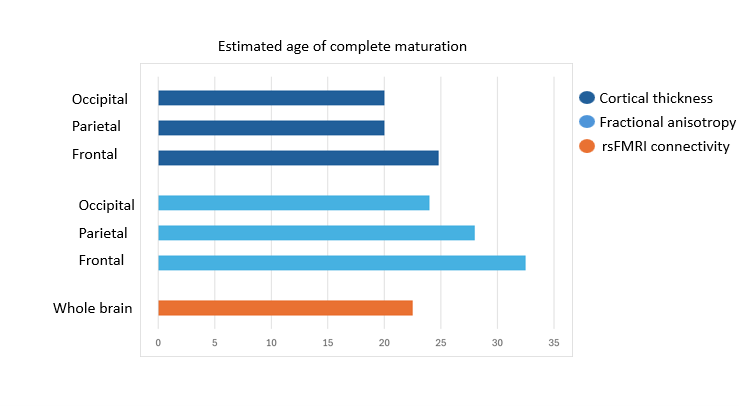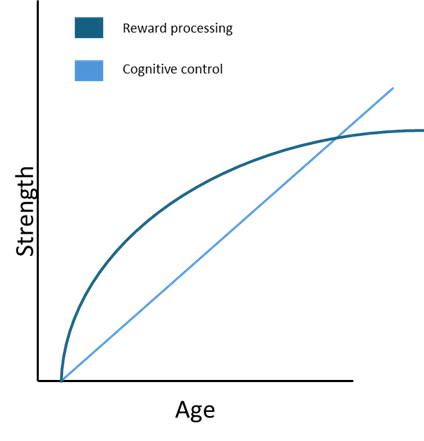Background
The boundary between adolescence and adulthood is a construct of societal and legal importance, particularly when considering legal culpability. Given the potential legal ramifications, the placement of such a boundary should be guided by empirical evidence. For this reason, developmental psychology and neuroscience have been increasingly depended upon for setting legal precedent when it comes to the rights, protections, and legal culpability of adolescents. [1] The Supreme Court has recognized that certain characteristics of youth, such as a lack of maturity, increased vulnerability to peer pressure, and an underdeveloped sense of responsibility, render them less culpable. [2] Landmark decisions handed down by the court have led to a shift in legal standards from permanent incorrigibility to transient immaturity when weighing culpability. The concept of transient immaturity is used to argue that adolescents should not be held to the same standards of culpability as adults and is increasingly utilized in adolescent criminal court cases to argue for more lenient sentencing and alternative interventions. This was highlighted in cases such as Roper v. Simmons (2005) and Graham v. Florida (2010), where the Court acknowledged that the impetuousness and recklessness of youth are transient and diminish with maturity that exists on a developmental spectrum. The arguments in these landmark cases were grounded in developmental psychology and neuroscience, which highlight the ongoing development of the adolescent brain. The Miller v. Alabama (2012) decision by the United States Supreme Court is a key example, where the Court eliminated mandatory life-without-parole sentences for juveniles, recognizing that youth are less culpable due to their developmental stage. Although these arguments, and the shift towards a standard of transient immaturity, are supported by a large body of neurodevelopmental evidence, transient immaturity itself is a rather vague term. Furthermore, the “bright line” drawn at 18 for accountability in the adult legal system remains in place, despite there being no scientific evidence to support such a definitive boundary. For these reasons, it is recommended by legal and scientific scholars that behavioral science guide policy and be consulted on a case-by-case basis. [3]
The Adolescent Brain
Using neurodevelopment as a guide for adolescent culpability requires an expert who understands and can adequately explain the developmental onset, duration, contributing factors, and individual differences associated within the context of the adolescent/case in question. Developmental milestones during adolescence include the onset of puberty, which triggers significant hormonal changes leading to physical growth and sexual maturation. From a neurodevelopmental perspective, adolescence is a period of unique and drastic change, typically spanning from ages as early as 10 to as late as 25, with a high degree of individuation. Indicators of brain development, such as resting-state functional MRI (rsfMRI) connectivity (an indicator of whole-brain brain connectivity), cortical thickness (thickness of the cerebral cortex), and fractional anisotropy (a measure of white matter integrity), show different maturation timelines across various brain regions [4], highlighting the ongoing development of critical areas well beyond what is anecdotally (and, often, legally) considered to be the end of adolescence.

Figure 1 - Adapted from Somerville (2016). Estimated ages of Biomarker maturation.
Beyond an understanding of the developmental trajectory, it is incumbent upon neurodevelopmental experts to describe the behavioral hallmarks tied to this period of development, and how this might impact culpability. Regions of the brain associated with sensation-seeking, novelty, and reward (including the limbic system, the region of the brain largely responsible for emotion and reward processing) undergo rapid development in early adolescence, whereas regions associated with planning and behavioral inhibition (prefrontal cortex) continue to develop well into late adolescence and early adulthood. [5] The imbalance in the developmental timing of these two brain systems is a hallmark of adolescent neurodevelopment and often referred to as the dual systems model. The net effect of such a system is that adolescents, by biological design, have a limited capacity for future planning and consequences compared to their proclivity for novelty, sensation-seeking, and risky behavior. Importantly, this model, and downstream behavioral implications, serve as the generally observed trend, and there are individual differences in reward processing and cognitive control throughout development. For this reason, it is critical that neurodevelopmental experts be able to provide additional analysis and evidence to adequately describe an adolescent’s neurodevelopmental capacity.

Figure 2 – Dual Systems Model. Adapted from Casey, Getz, & Galván (2008).
Implications in Real-World Settings
In legal settings, an adolescent’s ostensible ability, elicited under clinical conditions, to understand consequences and right versus wrong is often used as evidence that he or she has the same cognitive capacity as his or her adult counterparts in such matters. Indeed, studies have shown that, in tasks evaluating cognitive control, adolescents can perform equally well as adults. However, when such tasks include an emotional/arousal component (such as during the real-life circumstances of the alleged crime), adolescent performance drops substantially [6], demonstrating a propensity for impulsivity even for individuals 18-21 years old. [7] Research also suggests that adolescents are more likely to engage in risky behaviors when in the presence of peers due to social reinforcement and the desire for group acceptance. For instance, a study by Gardner and Steinberg (2005) demonstrated that peer presence significantly increases risk-taking in decision-making tasks. The study found that adolescents took more risks in a simulated driving game when observed by peers compared to when they were alone. [8]
What this tells us is that the imbalance known to exist in the adolescent brain disproportionately favors novelty/reward-seeking over cognitive control when both are required. This means that, based upon the published science, post-event interviews are not a realistic, appropriate, meaningful, or even fair assessment of the adolescent’s ability to distinguish right from wrong at the moment he or she committed the act of which he or she stands accused. For these reasons, it is quite difficult to remove the neurodevelopmental component from a case when considering adolescent culpability.
How Experts Can Help Support Your Case
Consultation with experts in adolescent neurodevelopment should have two primary aims: the first being to determine where in the neurodevelopmental timeline the individual in question is likely to fall. The goal is to provide context for the transient immaturity standard that the court is asked to consider. This can be achieved at the very most general level by referring to the body of literature that maps chronological age coarsely to neurodevelopment. This approach, however, fails to consider individual differences that are known to exist. A more specific approach could involve performing neuropsychological assessments on the individual in question in an effort to probe their cognitive/emotional capacity compared to adolescents in the general population. Such information, combined with environmental factors known to impact development, can be used to build a bespoke neurodevelopmental profile for a given adolescent. An even more involved approach might entail observing brain activity (e.g., via electroencephalogram-EEG) that can be compared to a normative standard while the individual engages in a task meant to probe cognitive/emotional capacity. In this way, one can most accurately place an adolescent at a specific point on the neurodevelopmental timescale. The second aim is for such experts to review the details of the case and provide an opinion as to whether the circumstances, combined with the individual’s stage of neurodevelopment, create a scenario in which reasonable behavior and decision-making are compromised by transient immaturity. These aims, when met, provide the trier of facts with vital information on the extent to which the individual in question can be found culpable.
Conclusion
An experienced Human Factors team can provide the above analysis with a high level of expertise. Potential experts that might be considered are cognitive neuroscientists whose expertise spans adolescence into adulthood. It is typically considered more helpful to a jury or trier of facts if such experts are able to opine on behavioral vulnerabilities for adolescents mapped onto their causative neural substrates, compared to relying on psychological evidence alone. [9] Scientific and legal precedent tells us that so long as there are cases involving adolescents, there will be a need for neurodevelopmental expertise so that a complete body of evidence can be presented, devoid of bias, and a just outcome assured.
Acknowledgments
We would like to thank our colleague Sam Franco-DeWitt, Ph.D. for providing insights and expertise that greatly assisted this research.
References
[1] Insel et al. (2022)
[2] See, e.g., Roper v. Simmons 543 U.S. 551 (2005); Graham v. Florida 560 U.S. 48 (2010); Miller v. Alabama 567 U.S. 460 (2012)
[3] Insel et al. (2022)
[4] Somerville (2016)
[5] Casey et al. (2010); Steinberg (2008)
[6] Somerville et al. (2011); Cohen-Gilbert & Thomas (2013)
[7] Cohen et al. (2016); Rudolph et al. (2017)
[8] Gardner & Steinberg (2005)
[9] Aspinwall et al. (2012); Weisberg et al. (2008)